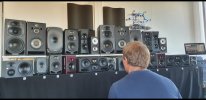So, I've had the opportunity to try the new Genelecs with the tweeter in the middle, Amphion One 18, PSi 17 and the Neumann KH310.
The Neumann KH310 are amazing, super linear, crazy low end and very smooth high end however, from a mixing perspective, it's really hard to identify the mid range and treble on these speakers and the low end seems to be somewhat overemphasized but I'd love to use them as a second pair listening setup, not for referencing though.
The new Genelecs are surprisingly linear as well with great mid range, not as overemphasized as the KH310 but really very wide low end range and good treble representation but the high end is really harsh and on longer mixing sessions would make me tame it / take out it when it wouldn't be necessary.
Just as the KH310s, the PSi A17 have an amazing listening experience but the low mids acuatically are hanging out like beer belly, they do sound nice from a listeners perspective, giving you a "warm" sound but to my ears not really linear. The lows are great, not as huge as on the KH310s but rather correct like the Genelecs and not overemphasized so actually translate well. Sadly, I really had a hard time pointing out the treble and could barely hear the high end. Great speaker for listening in my opinion or as a second referencing monitor such as the KH310 but not really for making critical decisions in the treble and high end. I actually expected the PSi 17a to sound completely different.
One big problem the PSis have, is the transient response, compared to the KH310, Genelecs and Amphions, I find it really dampened and not as responsive, very mushy.
I originally thought I'd prefer the PSis or the KH310s given all the reviews but to my surprise, the Amphion One 18s hit the mark. They have an incredible transient response, amazing mid, treble and high end extension where I'm able to exactly pin point Instruments' frequency representation. They don't have the same amazing low end representation as the KH310, Genelecs or PSi A17 but translate amazingly well in anything above. You also can't make them as loud as all the others but they are nearfield monitors and shouldn't be cranked that much I feel. But for it's size, they also have a surprisingly good low end. The high end also while being very present is smooth as hell and won't fatigue.
Compared to all the other speakers, the Amphion One 18s have the most transparent sonic representation without having any coloration or dampened area. If the Amphions hadn't been available, I probably would've picked the genelecs and dampened the tweeter a bit.
All of them had a great stereo image and widness.
But I do understand why the Amphions are so hyped, they have an amazing translation, impeccable transient response and would be a step up from my ProAc SM 100. Which have a little bit of a 100 - 150 Hz hump and 10k bump but as the Amphions also translated amazingly well and give a very transparent sonic representation.
I am first and foremost a mixing engineer and have honed that craft at an early age for the past 20 years which means I'm usually pushing untreated sources heavily into an area where they shine vs working on already finished tracks. In that regard, low mids, mid range, treble and high end are the most important frequency areas while making sure that the low end is as fat as possible without feeling out of place with the rest.

